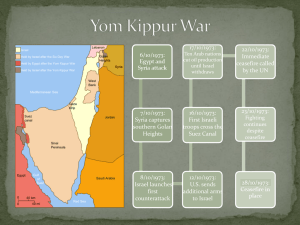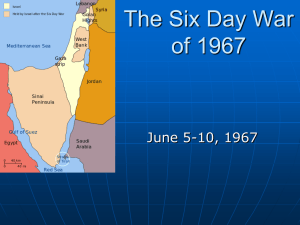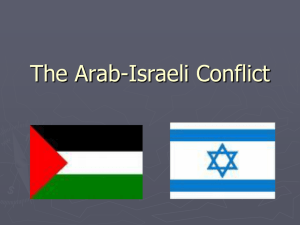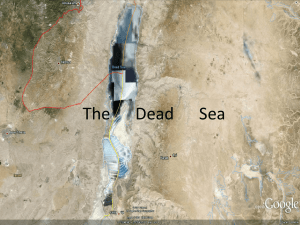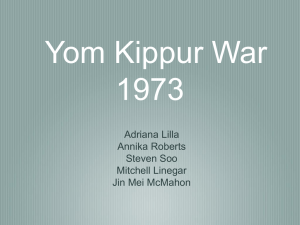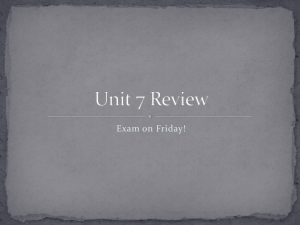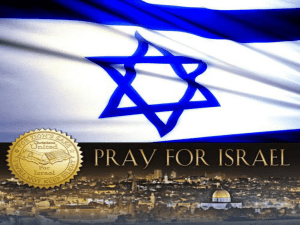Per6YomKippur-Susan, Corinna, Daniel, Phillippe
advertisement
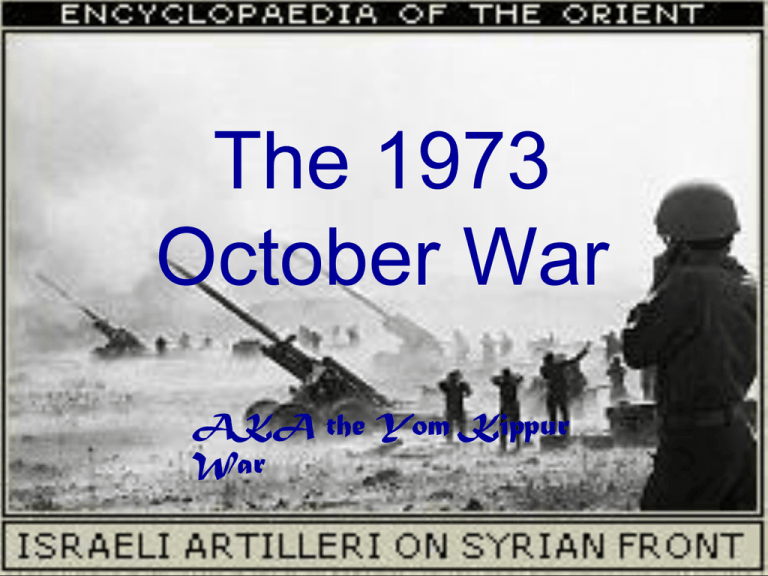
The 1973 October War AKA the Yom Kippur War TIMELINE 1. 2. 3. 4. 5. (10.06.1973): at 4am, Defense Minister Dayan was informed that Egypt and Syria were going to attack --at 2pm, Egypt and Syria attacked Israel as a ‘surprise attack.’ This perceived the Arab’s as weak and Egypt had just expelled its Soviet military advisors. (10.11.1973): Syrian forces were repelled. (10.18.1973): Israeli forces had crossed the Suez Canal. (10.20.1973): Kissinger flew to Moscow and drafted a ceasefire agreement with Communist Party. Chairman Leonid Breznev (10.22.1973): The cease-fire was accepted by all sides. Where the war took place: Arab Points of Contention • • • • • • • After being completely defeated by Israel in 1967, Arabs were unwilling to make peace. There were 350,000-400,000 Palestinian refugees. March 1969, Egypt starts the War of Attrition with Israel as a way to break the deadlock in hopes of eventually reclaiming the Suez Canal. Egypt received aid from the Soviet Union: weapons, technicians, and combat personnel. Egypt was enduring many losses, eventually accepted the US Secretary of State Roger’s Cease-fire proposal, but only if they pressured Israel to accept Resolution 242 and leave those occupied territories. War of Attrition ends August 8, 1970. Egypt sought a small military operation would be beneficial to their poor economic and political situation. On October 6, 1973, Israel was attacked by Egypt and Syria. Frustrated from surprise and the underestimated Arab frustration over Israeli occupation in Golan Heights, Sinai, West Bank, and the Gaza Strip. Israeli Points of Contention • • • • • • After Israel’s victory, Israel was not willing to make a peace treaty. With the war of attrition more than 1,000 Israeli soldiers were killed. Israel responded with bombardments on military and civilian targets along the canal . Israel now had gained control over more Palestinian land, the population was 665,000 Palestinians and an additional 350,000-400,000 Palestinians became refugees. During the beginning of 1973 , Israel felt American support and military aid, the decline in international pressure following the Munich Olympic massacre. Israel refused to withdraw to the pre-1967 armistice lines, they believed that its new boundaries were vital for its national security. With this act Israel and Egypt were not able to form peace. On October 6 1973, Israel was attacked by Egypt and Syria. This was came as a surprise to Israel, to the extent that Israel intelligence had failed to predict the confrontation despite evidence to the commentary. Outcome of the Yom Kippur War Consequences of the war were widespread. Nearly 8,500 Arab casualties were recorded with an economic loss equaling to a whole year’s GNP. On Israel’s side, some 6000 soldiers were killed and had an equal economic loss like Arabs. The war destroyed the image that Israeli forces are invincible and it became more dependent on U.S. for The war destroyed the image that aids relating to economy, military and Israeli forces are invincible and it diplomacy. became more dependent on U.S. for withdrew back military across the aids Israel relating to economy, andSuez Canal and several miles inland from the east bank of the Suez Canal behind an UN-supervised diplomacy. cease-fire zone. On the Syrian front too, Israeli territorial gains made in the war were given up. After the war Egyptian and Syrian diplomatic relations with the United States, broken since the 1967 war, were resumed, and clearance of the Suez Canal began. The Yom Kippur War brought about a major shift of power in the Middle Following Yomsigning KippurofWar the African states East and ultimately ledthe to the themost 1979ofIsraeli-Egyptian peace treaty.and some other Third World countries emulated the earlier action of the Soviet block and severed diplomatic relations with Israel. Key Figures • Syria: – Hafez al-Assad • Egypt: – Anwar Sadat – Ahmad Ismail Ali • Israel: – Golda Meir – Moshe Dayan – David Elazar – Avraham Adan Other Key Figures • • • • Henry Kissinger (U.S.) Leonid Breznev (USSR) King Faisal (Saudi Arabia) Houari Boumediene (Algeria) Key Battles • • • • • • • • • • • Battle of Fort Lahtzanit (October 6) Battles of Fort Budapest (October 6, 1973) First Battle of Mount Hermon (October 6-7) Operation Badr (October 6–8) Valley of Tears (October 6 –9) Second Battle of Mount Hermon (October 8) Air Battle of El Mansoura (October 14, 1973) Battle of the Chinese Farm (October 15–17) Battle of Ismailia (October 18–22) Third Battle of Mount Hermon (October 21–22) Battle of Suez (October 24–25) CREDITS Made by: Bridgette G, Corrina C, Daniel S, Phillippe L, and Susan C Used the Sources: -The Arab-Israeli Conflict by Kirsten E. Schulze http://www.palestinefacts.org/pf_1967to1991_ykwar_result.php http://www.historylearningsite.co.uk/yom_kippur_war_of_1973.htm
